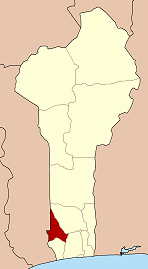Kouffo Department facts for kids
Quick facts for kids
Kouffo
|
|
|---|---|

Map highlighting the Kouffo Department
|
|
| Country | |
| Capital | Aplahoué |
| Area | |
| • Total | 928 sq mi (2,404 km2) |
| Population
(2006)
|
|
| • Total | 572 924 |
| • Density | 617/sq mi (238.3/km2) |
| Time zone | UTC+1 (WAT) |
Kouffo is one of the twelve main regions, called departments, in the country of Benin. It is located in the southwestern part of Benin. Kouffo shares a border with the country of Togo to its west.
The capital city of Kouffo is Aplahoué. This department was created in 1999. Before that, it was part of a larger department called Mono. Splitting into its own department helped manage the area better.
Contents
Understanding Kouffo's Geography
Kouffo covers an area of about 2,404 square kilometers (about 928 square miles). This makes it one of the smaller departments in Benin. In 2006, about 572,924 people lived there. This means it has a population density of about 238 people per square kilometer.
Where is Kouffo located?
Kouffo is in the lower part of Benin. It is known for its flat lands and some rolling hills. The department gets its name from the Kouffo River, which flows through the region. This river is important for local farming and daily life.
Climate and weather in Kouffo
The climate in Kouffo is tropical. This means it is generally hot and humid. There are two main seasons: a rainy season and a dry season. The rainy season brings most of the year's rainfall, which is important for agriculture.
Life in Kouffo: Communes and Communities
Kouffo is divided into smaller areas called communes. Think of communes like counties or large towns. Each commune has its own local government. These communes help manage services for the people living there.
The Communes of Kouffo
The department of Kouffo has six communes:
- Aplahoué: This is the capital and a central hub for the department.
- Djakotomey: Known for its local markets and community activities.
- Klouékanmè: An important agricultural area.
- Lalo: Another commune with strong farming traditions.
- Toviklin: A commune that plays a role in local trade.
- Dogbo: This commune is also a key area for farming.
How communes are governed
Each commune has a mayor and a local council. These leaders are chosen by the people who live in the commune. They work to improve things like schools, health centers, and roads. They also help with local development projects.
Economy and Daily Life
Most people in Kouffo work in agriculture. The fertile land and the Kouffo River support many types of farming. This helps feed the local population and provides goods for trade.
Farming in Kouffo
Farmers in Kouffo grow many different crops. Some of the main crops include maize (corn), cassava, yams, and palm oil. These crops are essential for the local economy. They are sold in local markets and sometimes traded with other regions.
Local markets and trade
Markets are very important in Kouffo. They are places where people buy and sell goods. Farmers bring their crops, and artisans sell handmade items. These markets are also social places where people meet and share news.
Culture and Traditions
The people of Kouffo have a rich cultural heritage. Many different ethnic groups live in the department, each with its own traditions. The Adja and Fon people are among the largest groups.
Languages spoken in Kouffo
The official language of Benin is French. However, many local languages are spoken in Kouffo. The most common ones include Adja, Fon, and Mina. These languages are used in daily conversations and for cultural events.
Festivals and celebrations
Traditional festivals are an important part of life in Kouffo. These events often involve music, dancing, and storytelling. They celebrate harvests, historical events, or spiritual beliefs. They are a way for communities to come together.
Images for kids
See also
 In Spanish: Departamento de Kouffo para niños
In Spanish: Departamento de Kouffo para niños


